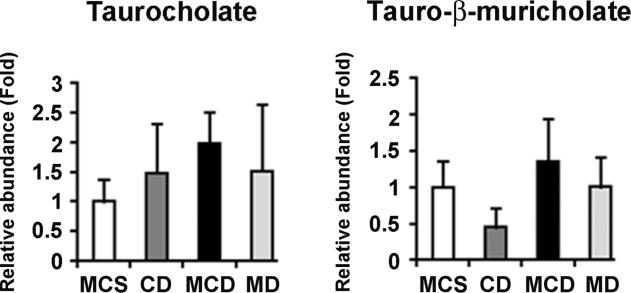We thank Drs. Gabbi and Gustafsson for their interest in our study on serum metabolomic analysis of nonalcoholic steatohepatitis (NASH) in mice (1). We measured the hepatic contents of taurocholate and tauro-β-muricholate using ultra-performance liquid chromatography-electrospray ionization-quadrupole time-of-flight mass spectrometry. However, the hepatic levels of these bile acids were not decreased in mice treated for two weeks with a methionine- and choline-deficient (MCD) diet (Fig. 1). Although changes in expression of the canalicular bile acid transporters were not detected, hepatic bile excretion might be decreased to some degree. When hepatic bile acid levels are altered, the expression of small heterodimer partner (Shp) may be changed accordingly to maintain hepatic bile acid levels. Indeed, the levels of Shp mRNA were decreased by MCD treatment, even in the absence of a significant decrease in hepatic bile acid content (Fig. 2). These findings suggest an abnormal response of transcription factors and their target genes associated with bile acid homeostasis, and thus we propose a disruption of bile acid homeostasis during the course of NASH where pro-inflammatory cytokines and cellular stress may disrupt bile acid homeostasis, causing a vicious cycle. Thus, we are generally in agreement with Drs. Gabbi and Gustafsson's view that clarification of the dynamic changes in bile acid homeostasis and the related transcriptional factors during NASH development might lead to new bile-modulating therapies for NASH.
Fig. 1. Hepatic levels of taurocholate and tauro-β-muricholate in mice treated for 2 weeks with methionine- and choline-supplemented control diet (MCS), choline-deficient diet (CD), methionine and choline-deficient diet (MCD), and methionine-deficient diet (MD).
The levels of bile acids were normalized to those of MCS-treated mice and were expressed as relative abundance. Values were expressed as mean ± standard deviation (n = 5 in each group) and statistical analyses were performed using the one-way ANOVA with Tukey's test.
Fig. 2. Time course of Shp mRNA levels during treatment with MCS and MCD diets.
The mRNA levels were normalized to those of 18S ribosomal mRNA and subsequently normalized to those of mice after a 3-day MCS diet treatment. The values were expressed as expressed as mean ± standard deviation (n = 5 in each group) and statistical analysis was performed using the two-tailed Student's t-test in the same treatment period. *, P<0.05, **, P<0.01.
References
- 1.Tanaka N, Matsubara T, Krausz KW, Patterson AD, Gonzalez FJ. Disruption of phospholipid and bile acid homeostasis in mice with nonalcoholic steatohepatitis. Hepatology. 2012 doi: 10.1002/hep.25630. [DOI] [PMC free article] [PubMed] [Google Scholar]




